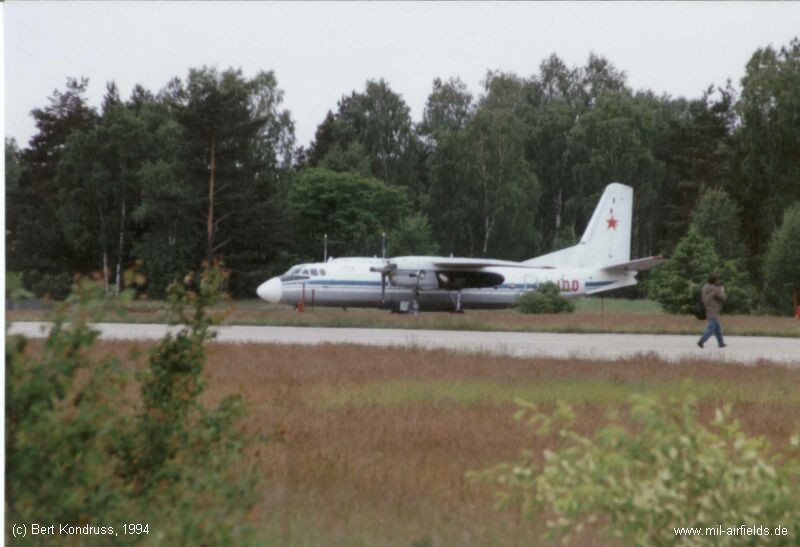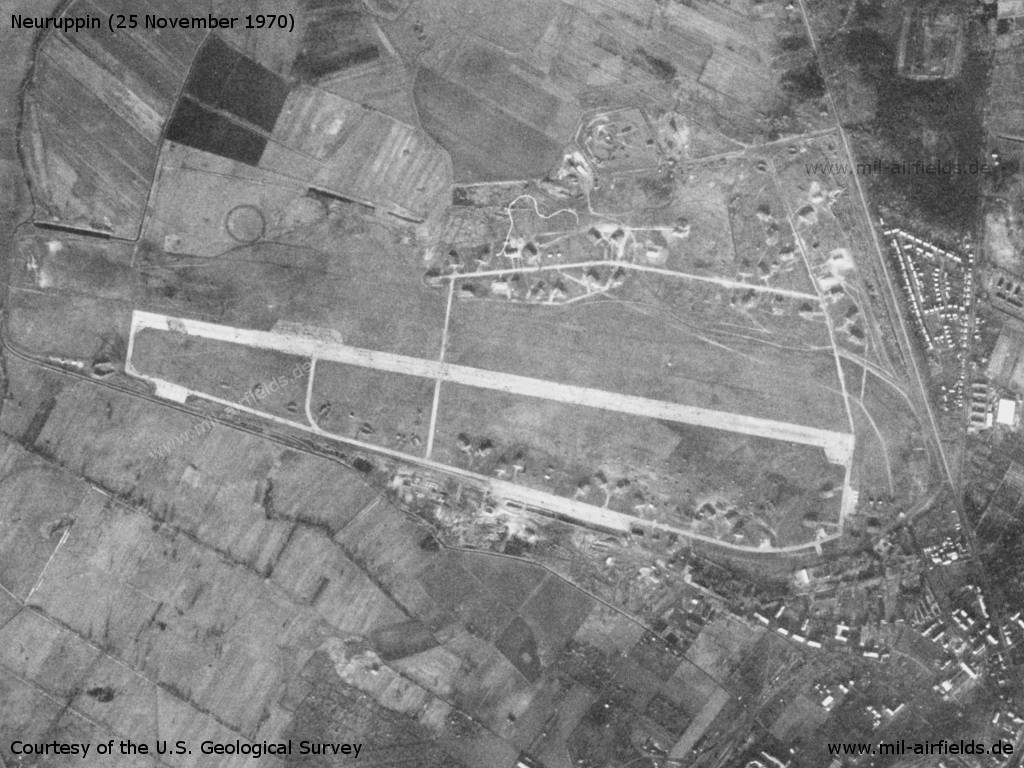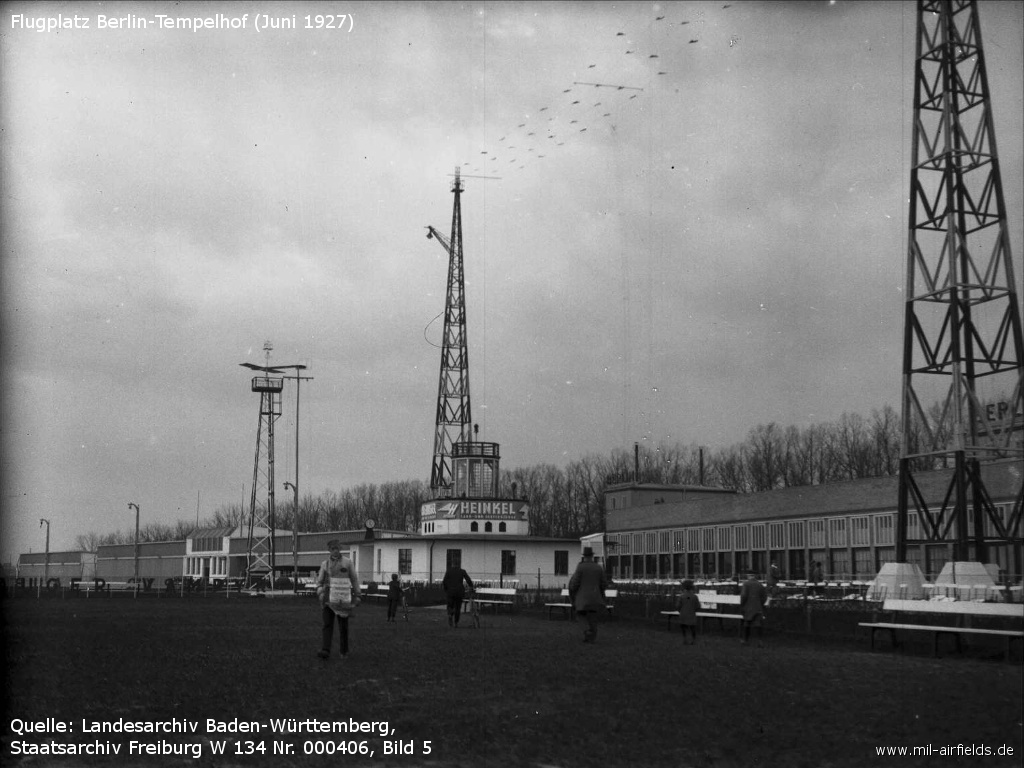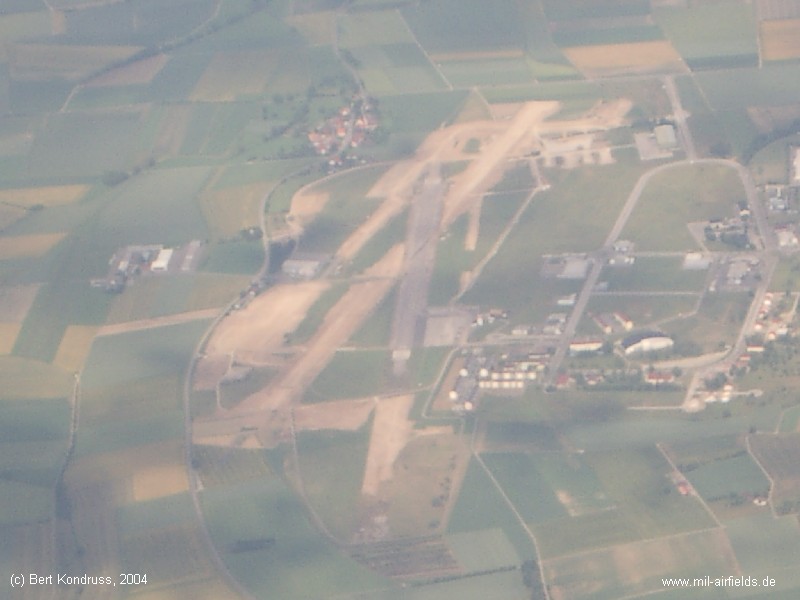For historical information only, do not use for navigation or aviation purposes!
| Coordinates | N524346 E0131250 (WGS84) Google Maps |
| Elevation | 35 m |
| Former East Germany (GDR) | District of Potsdam |
| Federal state | Brandenburg |
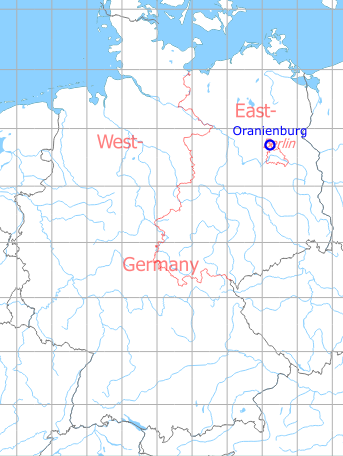
Germany during the Cold War Map
The history of the Cold War airfields: Oranienburg
Contents
During World War II
Use
Airfield of Heinkel aircraft manufacturing company.
Situation
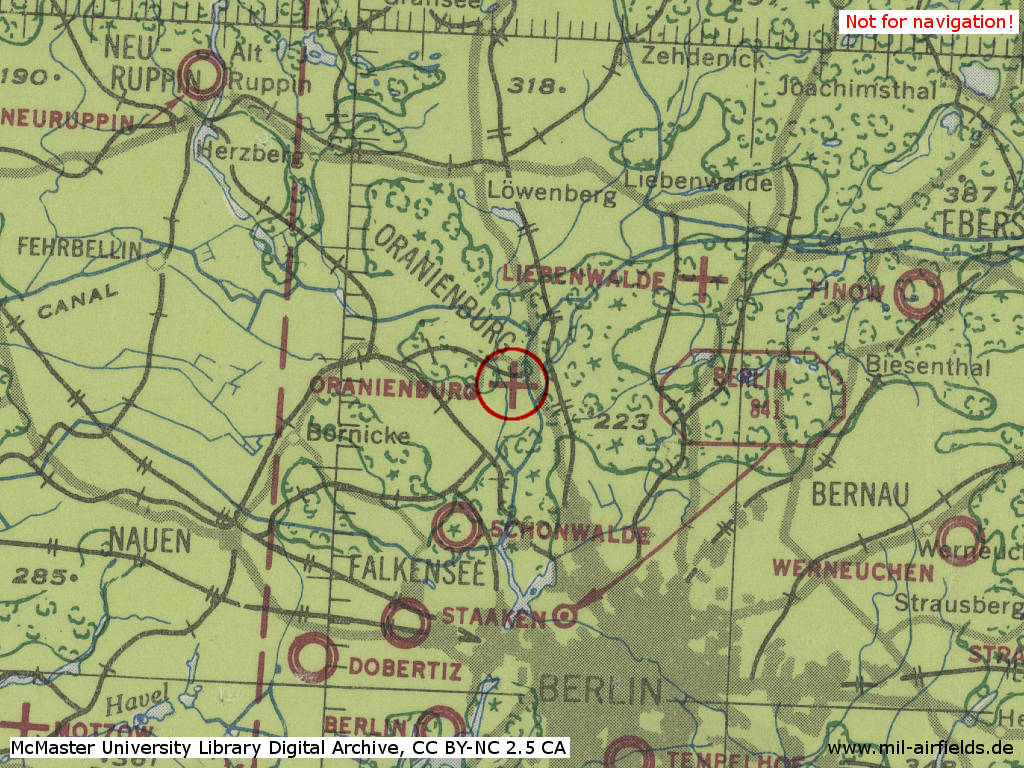
Oranienburg Airbase in World War II on a US map from 1943
Source: McMaster University Library Digital Archive, Lizenz: Creative Commons Attribution-NonCommercial 2.5 CC BY-NC 2.5 CA /MULDA/
During the Cold War
Use
Soviet air base for bomber, transport aircrafts, later helicopters.
In the 1940s
Situation
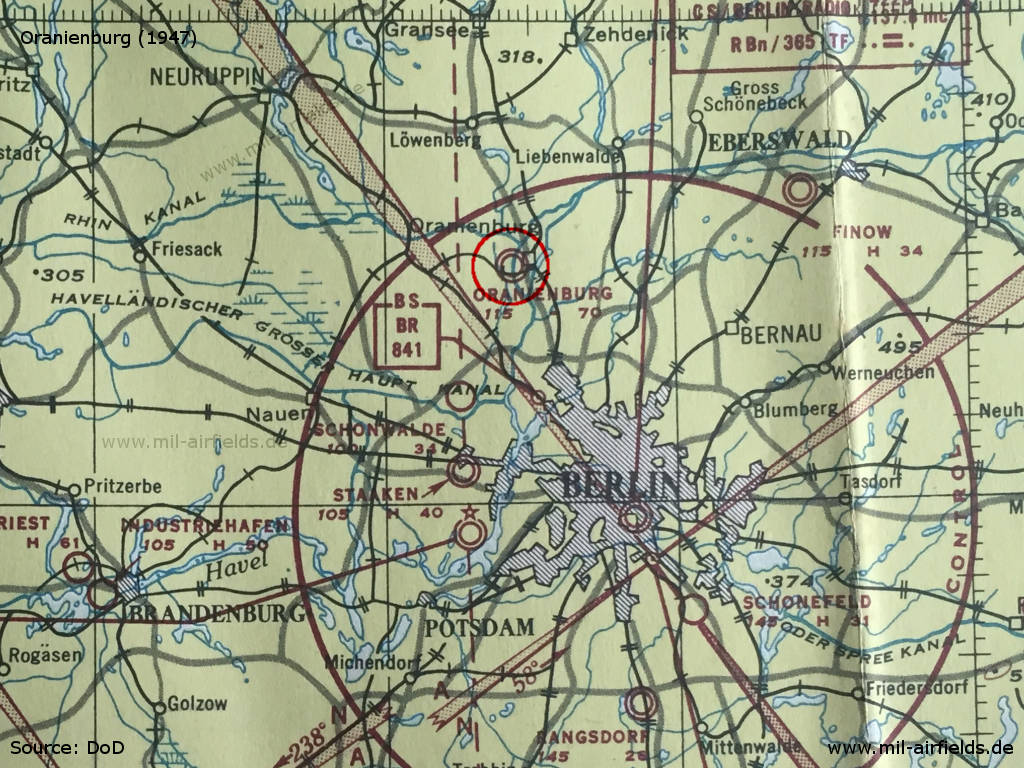
Oranienburg Air Base on a US map from 1947
History
Unless otherwise stated, the source of the information is the CIA.
- 26 January 1947
Thirty Pe-2's were seen on the field. Some of their cockpits were marked with yellow circles. Only the northern part of the field was being used. The fuel dump contained 150 to 180 barrels of gasoline. No air activity was observed. - 20 December 1947
40 Pe-2 and 10 Jak-4 were counted at the airfield. - Mid-1948
Approximately 65 Pe-2's, with engines, turrets and sensitive parts covered, were parked along the canal south of the field on ... There was no air activity. Only one hangar is being used. Barracks between the field and the Berliner Straße are occupied in considerable strength by Soviet Air Force units and some parachute troops. - Mid-1949
Construction work is being carried out at the airfield to extend the north-south runway to the south. - September 1949
In early September 1949 the Soviet bomber regiment with airplanes Pe-2, stationed at the airfield Oranienburg, relocates to the Cottbus Air Base. - September 1949
A Soviet fighter regiment with Yak-3 planes is relocated from Stendal Air Base to Oranienburg. - 11 December 1949
A train of 37 flatcars loaded with aircraft parts, including fuselages, wings etc. passed through the Oranienburg railroad station on 11 December 1949. The shipment coming from the Soviet Union via Frankfurt/Oder was for the air force unit in Oranienburg. It is assumed that the shipment includes jet planes. - 29 December 1949
A witness observes for the first time three jet planes parked around the hangar.
In the 1950s
Overview
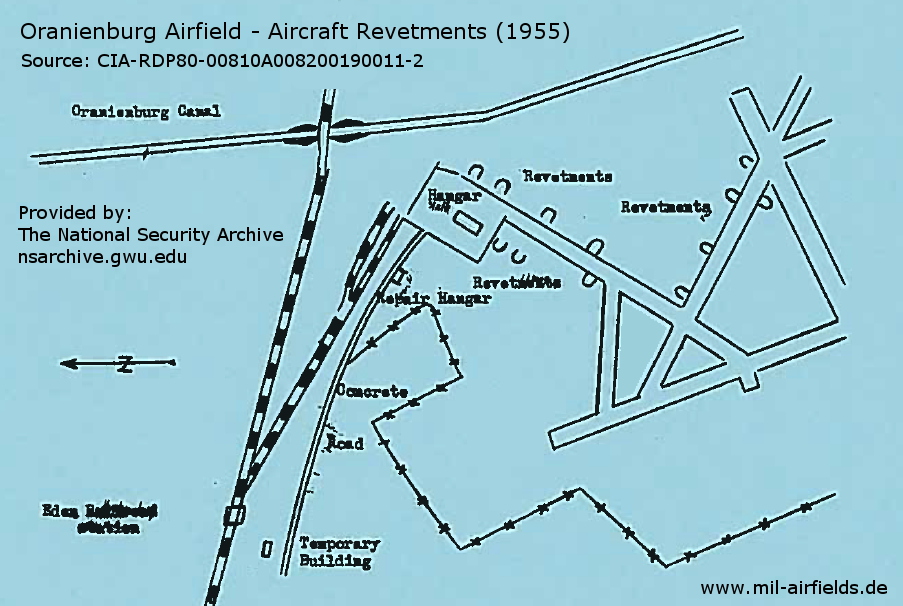
US sketch 1955
Source: CIA 1955
History
Unless otherwise stated, the source of the information is the CIA.
1950/51
- 03 January 1950
Another train from the Soviet Union with aircraft parts passes through the Oranienburg railroad station, destined for the Oranienburg Air Base. - March 1959
The CIA estimates from observations that meanwhile there are about 20 jet planes stationed in Oranienburg, mainly MiG-15 and a Jak-17. In addition, there are still Yak-3 or Yak-9 from the regiment's existing stock. - May 1950
Four jet planes are standing in the southeast corner of the field. Their engines are repeatedly revved up for 2 minutes, raising large clouds of dust. It is believed that these planes are kept ready for immediate take-off. - 1950
A shipment with 10 tons of medical instruments was dispatched from Oranienburg airfield to Großenhain airfield. In fact, however, these were spare parts for aircraft. - Mid-1950
More trains with aircraft parts arrived in Oranienburg. It is believed that more jet planes have arrived. - August 1950
Large wooden crates were being unloaded from eight railroad flatcars standing on the spur track at the field. Each crate was about 3x9 to 10 meters and had a bulge on the front side. They were stored on a temporary wooden ramp. One crate was opened at the straight side and the rudder assembly of a jet fighter with swept-back wings was identified. Six to eight such crates arrived at the field daily after 21 August 1950. - January 1951
The Soviet fighter regiment with 30 jet fighters and 6 single-engine propeller fighter planes is relocated to Neuruppin Air Base. - January 1951
A Soviet bomber regiment relocates from Strausberg airfield to Oranienburg. - April 1951
The airfield is occupied by a bomber regiment with about 40 aircraft Pe-2. - April 1951
The first Il-28 arrive at the field. - May 1951
It is estimated that the field is occupied by approximately 20 Pe-2 and 30 Il-28. In addition, there are 4 to 6 North American B-25 in Oranienburg. - September 1951
It is estimated that about 40 Il-28 Beagle belong to the Soviet bomber regiment. In addition, it is assumed that the reconnaissance regiment from Schönwalde Air Base or at least parts of it are in Oranienburg for retraining to Il-28. - December 1951
The Soviet bomber regiment relocates with its Il-28 to Brand Air Base, which has been expanded since early 1951. There are indications that a part of the regiment has been transferred to Finsterwalde Air Base: (trains which went from Oranienburg to Schacksdorf, 9 Il-28 were observed in January 1952 first in Finsterwalde, in Brand were fewer Il-28 than originally in Oranienburg)
The following pictures are taken from a CIA report from April 1951. They show the first Ilyushin Il-28 Beagle shortly after their arrival in Oranienburg.
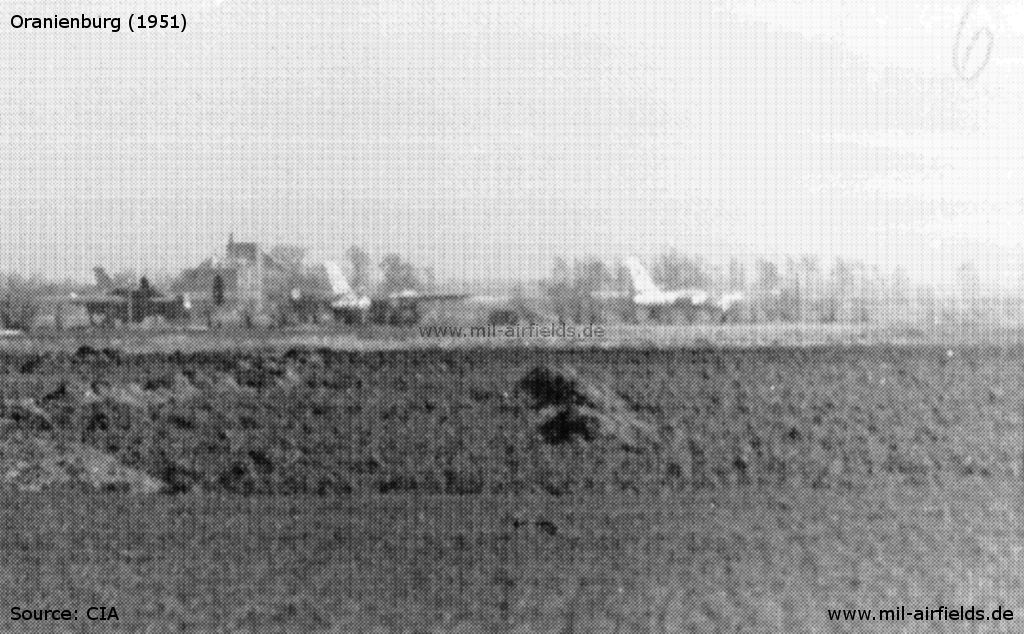
Soviet bombers of the type Il-28 and a plane North American B 25 at Oranienburg Air Base
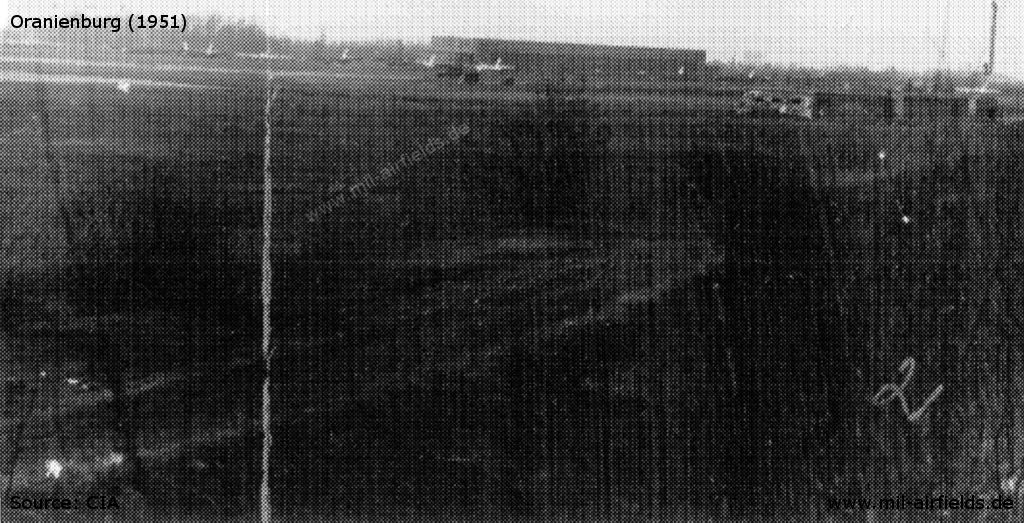
Numerous Il-28 are scattered around the field.
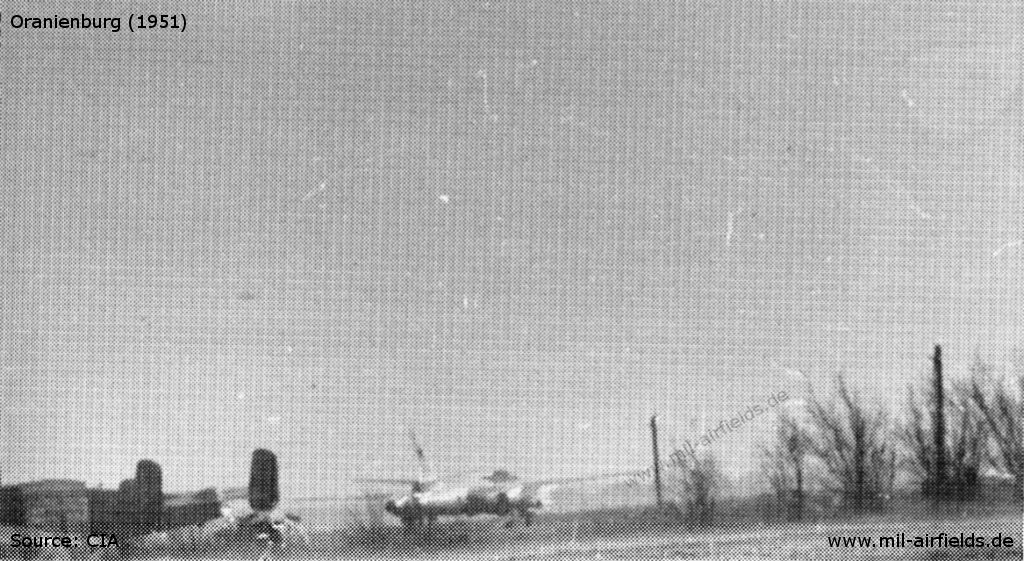
North American B 25 and Il-28
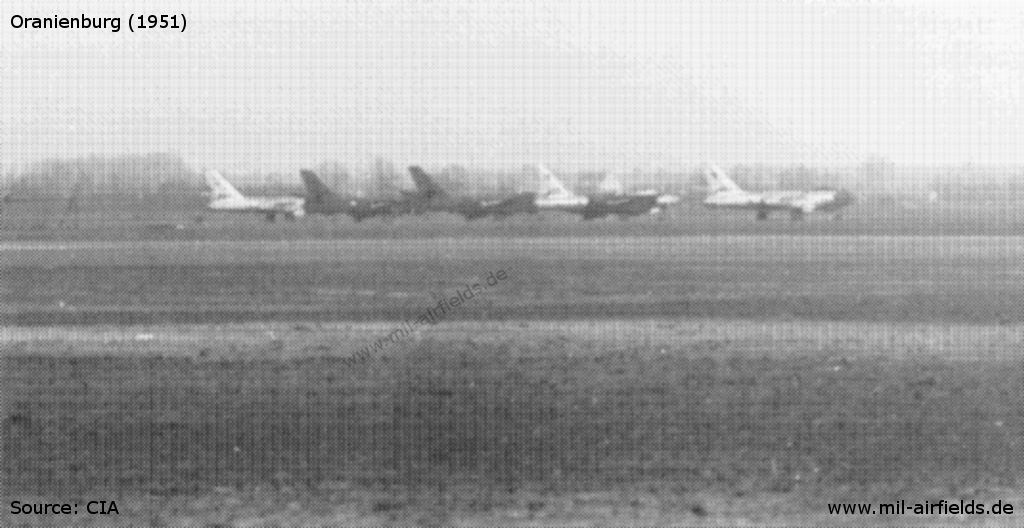
Ilyushin Il-28 Beagle
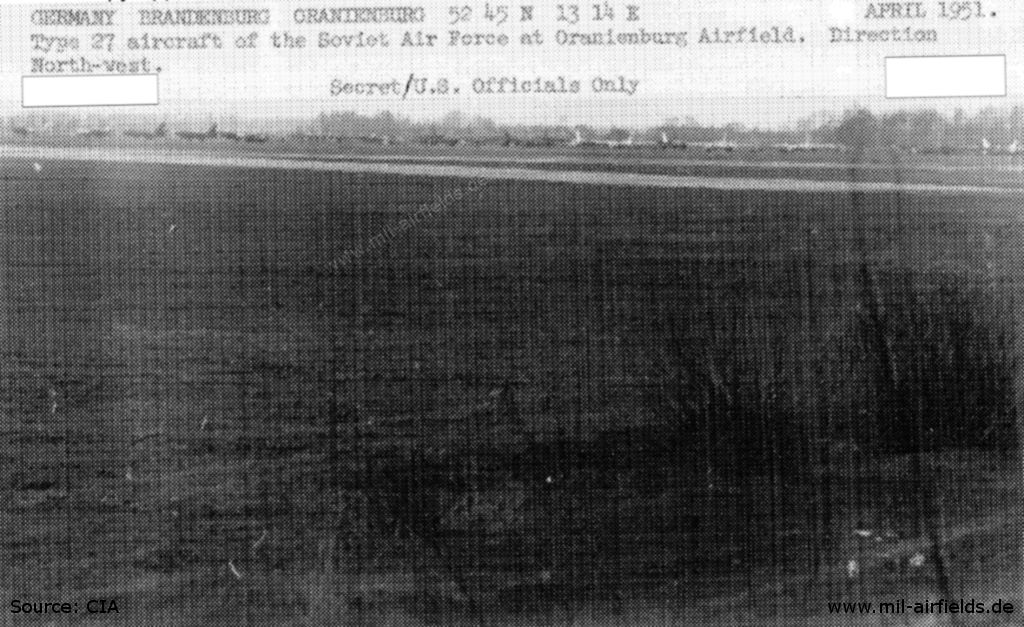
Aircraft at Oranienburg airfield
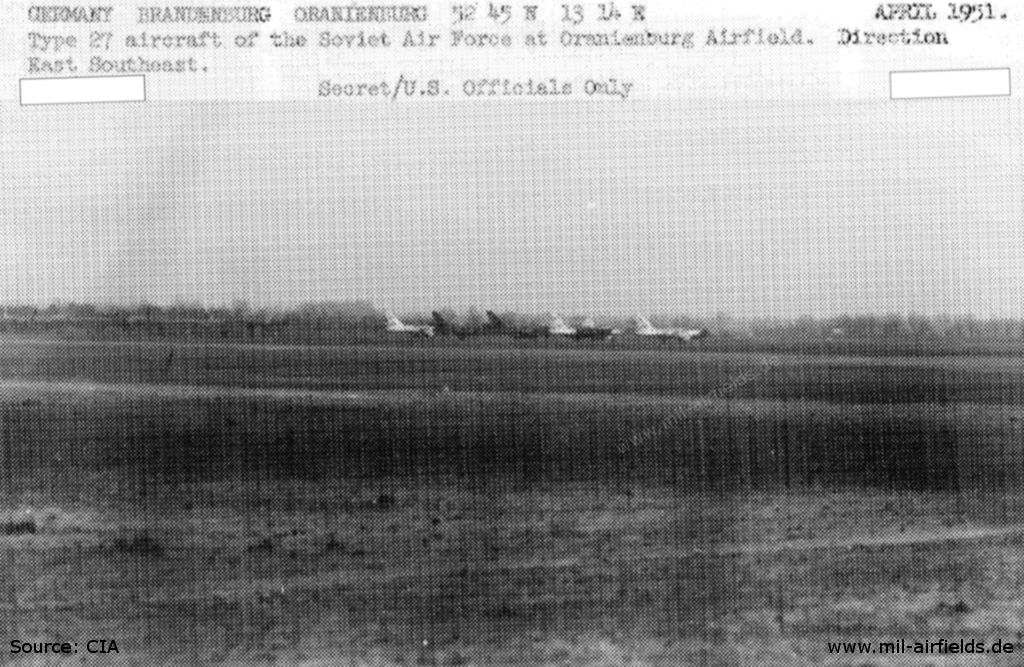
Il-28 Beagle
1952-1954
- January 1952
No planes are based on the aerodrome. There are indications that the runway is no longer usable and needs a new pavement. - February 1952
The airfield is heavily guared, security measures had allegedly been intensified because of an espionage incident. - March 1952
There are no planes parked on the field, the hangars are closed and there are no railroad cars on the siding. At first, there are no signs of construction work. In mid-March, the grass is plowed to plant new grass. At the end of the month, a unit with construction machinery arrives at the site and preparations for the construction of a runway are observed. - Beginning of April 1952
No flying was observed. The hangars were open and were being cleaned. A group of five surveyors led by an officer was observed. - 11 April 1952
A military celebration appeared to be held at the field. Firing was heard throughout the day at the target range. About 10 a.m., a military band was playing. At the same time, two jet fighters landed at the field the boundaries of which were marked by little flags. The two fighters continued to take off and land at intervals of about 30 minutes until about 5 p.m. A ground signal was fired from a pistol before each landing. At 4 p.m., a twin jet plane circled once over the field at a low altitude. - May 1952
There is no work in progress yet. At the end of May, consultations take place on how to renew the runway. - June 1952
Surveying work is being carried out at the airfield, including the extension of the runway to the south. The survey is carried out by two companies from Saalfeld and Leipzig. At the end of June, construction work is postponed to mid-July, as Bauunion Leipzig allegedly refuses to accept the contract. Apparently, negotiations are also underway with Bauunion Berlin. - July 1952
The surveying work was completed at the beginning of July. The original runway is 2125 m long and will be extended by 100 m in the north and 400 m in the south. In mid-July, the runway is staked off, including the extension to the southeast over cultivated fields. At the northwestern end, however, no preparatory work is observed. Workers and machines from Leipzig arrive on the field. - August 1952
Between 12 and 22 August, there were about 300 laborers working on construction projects at Oranienburg airfield. Work was done from 6:30 a.m. to 5:30 p.m. - Between 12 and 22 August, the spur track near Annahof was extended to the south as far as the road between Wilhelminenhof and Antonienhof. Construction materials were shipped by rail to the storage site where the concrete was to be prepared.
- A narrow-gauge railroad track was being laid on the long runway, starting at the northern end of the old runway to a place in line with Antonienhof. A branch line led to the mixing site and the cement sheds. Three Diesel locomotives and a motor driven roller arrived between 12 and 22 August.
- Between 12 and 22 August, the area north and south of the runway extension was plowed by the Machine Tractor Station. The sod was piled up and was to be shipped away. Leveling and surveying teams were working at the airfield.
- Every day, horse-drawn cars loaded with boards and logs arrived at the field. The boards and logs were piled up near the cement sheds.
- About 500 meters northwest of Wilhelminenhof, a sodded area of 30 x 400 meters was plowed. This area was to become the storage site for gravel and crushed stones. Cement was to be stored in two wooden sheds erected there, and the concrete ws to be mixed at this place.
- Excavation work for the northern and southern extension of the runway was started on 25 August 1952.
- On 28 August, three concrete mixing machines, two new model IFA diesel locomotives and a steam locomotive arrived by rail. ... gravel, crushed stone and cement were daily shipped to the field.
- Work on widening of the runway was not undertaken. The previously observed marking which indicated that the runway was to be widened had been removed.
- In late August, two buildings, one for the storage of broken stones, the other one for gravel were being built at the construction supply dump.
- Between 28 August and 5 September, two additional sheds were being built west of the first material dump at Oranienburg airfield. Four diesel locomotives and 30 lorries were counted on the narrow-gauge field railway tracks.
- In late August, about 400 workers and on 8 September about 1,000 workers including 200 women were employed at Oranienburg airfield. All the workers were issued metal tags on which consecutive numbers were stenciled and which had to be presented when tools were issued.
- September 1952
The concreting of the northern extension of the runway was started on 01 September. - After 3 September, about 150 railroad carloads of construction materials arrived daily at the field. Cement was delivered from Rüdersdorf and stones from Saxony.
- In early September all defective spots of the runway were being repaired. On 4 September this work was discontinued. The asphalt cover of the old runway was about 10 cm thick. On 3 September excavation work of the northern and southern extension of the runway was still under way.
- On the morning of 6 September, 23 railroad carloads of gravel, 3 carloads of cement and 2 carloads of broken stones were unloaded.
- Between 9 and 16 September 1952, about 1,000 workers were employed at Oranienburg airfield. Gravel, crushed stones and cement continuously arrived at the field.
- The old runway which was damaged in many spots was being covered with a new concrete layer. Ist old concrete cover was removed with pneumatic hammers. The northern extension of the runway was not yet concreted because the excavated strip was still to be filled with gravel.
- After 22 September, work was being done in three shifts. An average of 40 carloads of construction material, such as crushed stones, gravel and cement, daily arrived at the construction material dump.
- Security measures at the field were tightened after the RIAS broadcasting station had transmitted an exaggorated report on the construction of an airfield near Oranienburg between 28 September and 4 October. Volkspolizei were employed for guard purposes. Posters at Leegebruch informed the local population that the airfield area was off limits to all unauthorized persons.
- October 1952
Prior to 10 October, the old runway was being re-surfaced at several places. Five mixing machines were used for this purpose. ... about one third of the runway had been re-surfaced. - Gravel and cement were being shipped to Oranienburg airfield at an increased rate. Work on the levelling of the area adjacent to the first third of the runway was started, while concreting work was under way on the third section of the runway. Concreting work on the old runway continued.
- November 1952
On 20 November, the old runway was completed except for a strip of 30 meters. The runway had a width of 14 concrete slabs, the 12 middle-slabs of which had a width of 3.75 meters each while the slabs both at the western and eastern edges was 2.5 meters wide. Thus, the runway had a total width of 50 meters. All the slabs were 6 meters long. The northern extension of th the runway which had a length of 100 meters was completed on 17 November. The southern extension, 260 meters long, was being filled with sand and gravel up to 14 November. Premliminary work such as planking for the concrete slabs was completed but concreting work was not yet started. A strip, 150 x 3.75 meters, was concreted there prior 20 November. The slabs in this extension also had a length of 6 meters. - December 1952
On 29 November 1952, concreting work at Oranienburg airfield was discontinued because of the frost. Only a few workers who were still employed at the field were engaged in construction work on the fence and concreting on the southern extension of the runway. The target date for the completion of the main runway, which was fixed on 1 December 1952, was not kept. - On 21 January 1953, a large bomb, allegedly a 1000 lb. bomb, exploded close to the intersection of the runway with the northwest-southeast lane. According to a fire man, the fuze was already removed from the bomb and the detonation occured when some Russians were removing the explosive. A truck loaded with explosive powder which was parked in the vicinity of the bomb was blown up by the detonation. Allegedly, some Soviets and Germans were killed by the accident. The window panes of the houses and resettlers' buildings in the vicinity were broken. The bomb crate was about 15 meters in diameter. One day after the accident, SED men went from house to house in the surrounding villages telling that only one person was killed and that otherwise no serious damage was caused.
- August 1953
In mid August 1953, construction machinery and equipment were loaded at the field and, allegedly, shipped to Tutow and Schorfheide. On 14th August light poles and field railway tracks were also loaded. The laborers who remained at the field performed repair work on the runway and taxiways. Cracks in them were blasted, which however caused new damages. Source learned ... of Bauunion Leipzig that work at the field had to be completed by 15 August, the only exception being a hangar which was to be completed by 01 September. Source determined that the new connecting taxiway was 660 m long. One aircraft revetment. was observed on both sides of the eastern portion of this taxiway. - In mid-August, 13,000 Eastmarks were allocated for improvement work on Hans-Schemm school in the Weiße Stadt restricted area in Oranienburg. This is in addition to 12,000 Eastmarks allocated previously.
- In early August, excavating work for the fuel dump in the north eastern corner of the field, parallel to the canal, had to be discontinued because the subsoil water level was reached at a depth of 1.6 m. Source learned that it had been planned to excavate the ground to a depth of 6 m. The fuel dump is scheduled to have a capacity of 1,000,000 L.
- Source learned that the subsoil water level at the field had risen because the Soviets had filled up the drainage channels with earth or cement.
- Prior to mid-August, 24 aircraft revetments have been completed. The ... that no more aircraft revetments would be erected because part of the pre-fabricated sections used in the revetments have been damaged when they were shipped. Aircraft revetments and taxiways were provided with camouflage painting.
- On the morning of 18th August an acceptance commission consisting of Lieutenant Colonel R (first name unknown), several gentleman from Werder and the construction supervisor from Schorfheide airfield arrived at Oranienburg airfield. Source learned that the runway and taxiways were not accepted because they showed cracks and uneven spots. A new date for acceptance was fixed for 31 August.
- In mid-August, construction work on the fuel dump continued. On 20 August, a total of 513 laborers were employed at the field. 50 percent of the workers were sick or on leave. All female laborers except for the kitchen personal happen given notice.
- In late August, construction work was going on in the northeastern corner of the field, on the western bank of the canal. Four concrete structures, probably foundations, were observed there. Prior to 7 September no aircraft were seen at the field.
1955
Data from 1955 is from a intelligence report which was released by the CIA in 2009, see link to the National Security Archive below /CIA 1955/. The report consists of 13 topics and 6 comments. The topics are arranged here in chronological order. Several passages, the whole topic 6 and the whole comment 3 are redacted. The text also references a comment 7, which seems to be already missing in the original document.
- The reconnaissance regiment moves to the Jüterbog / Altes Lager Air Base.
1959
- 1959
In case of a war, Oranienburg airfield would have had priority 95 as target for US attacks with nuclear bombs at eastern block airfields (including the Soviet Union and China). Within East Germany ("GDR"), it held the third place at this time, after Groß Dölln (priority 70) und Werneuchen (priority 82). (Source: Targets 1959)
In the 1960s
Situation
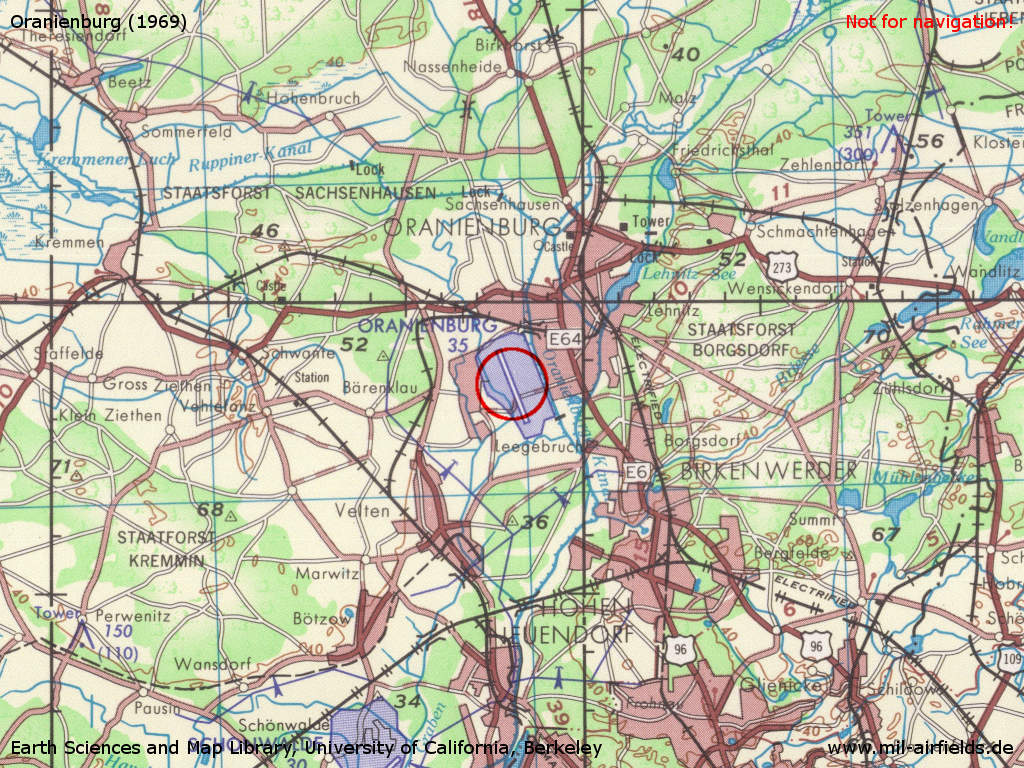
Oranienburg Air Base on a US map from 1969
Source: Earth Sciences and Map Library, University of California, Berkeley
Overview
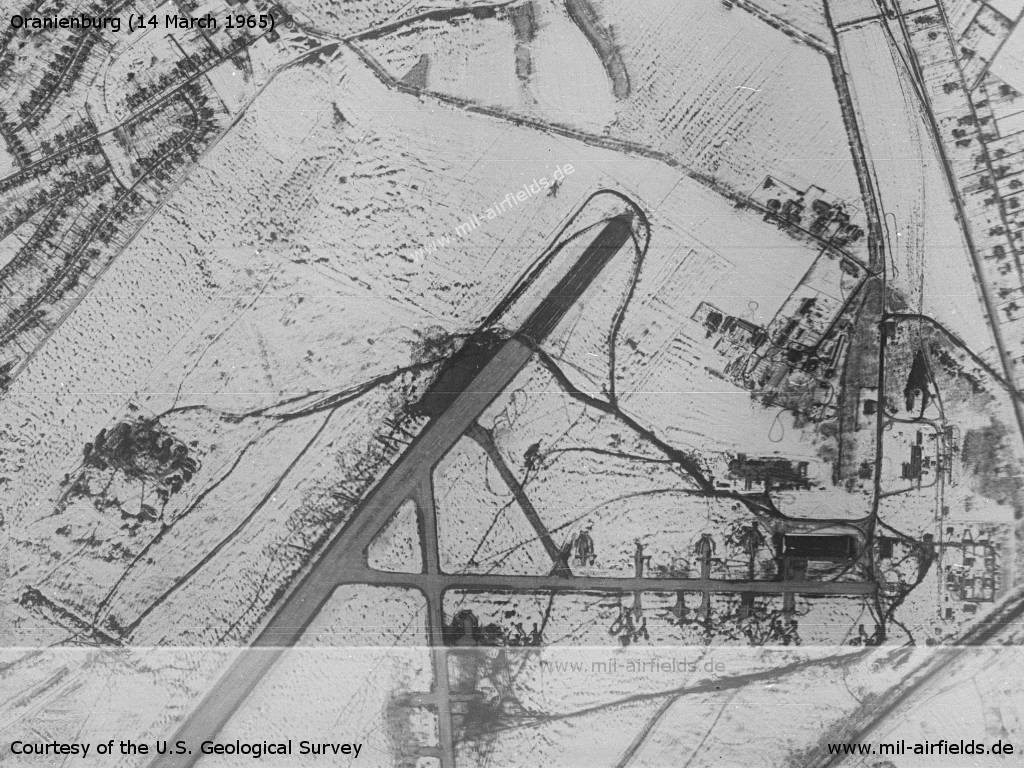
On Sunday, 14 March 1965, the landscape around Berlin is covered with snow. - However, the runway in Oranienburg has been cleared.
Source: U.S. Geological Survey
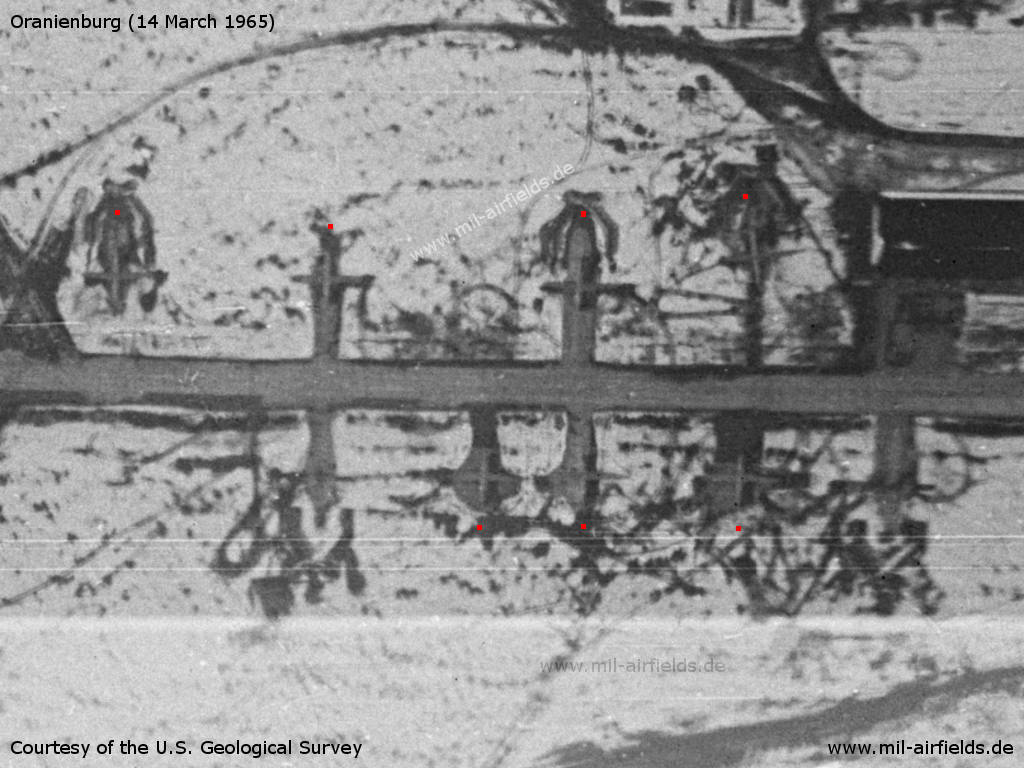
Enlargement: Soviet transport aircraft at Oranienburg airfield - (I marked the planes with a red dot)
Source: U.S. Geological Survey
History
- 22 June 1961
The Soviet controller at the Berlin Air Safety Center (BASC) protested that an American C-47 on a local flight was overflying Oranienburg airfield at 100 meters, interfering with flights, and requested corrective action. The US Mission concluded after investigation that the C-47 had not violated quadripartite safety rules and so notified the Soviets. (Source: CIA Berlin 1961-06)
In the 1970s
Situation
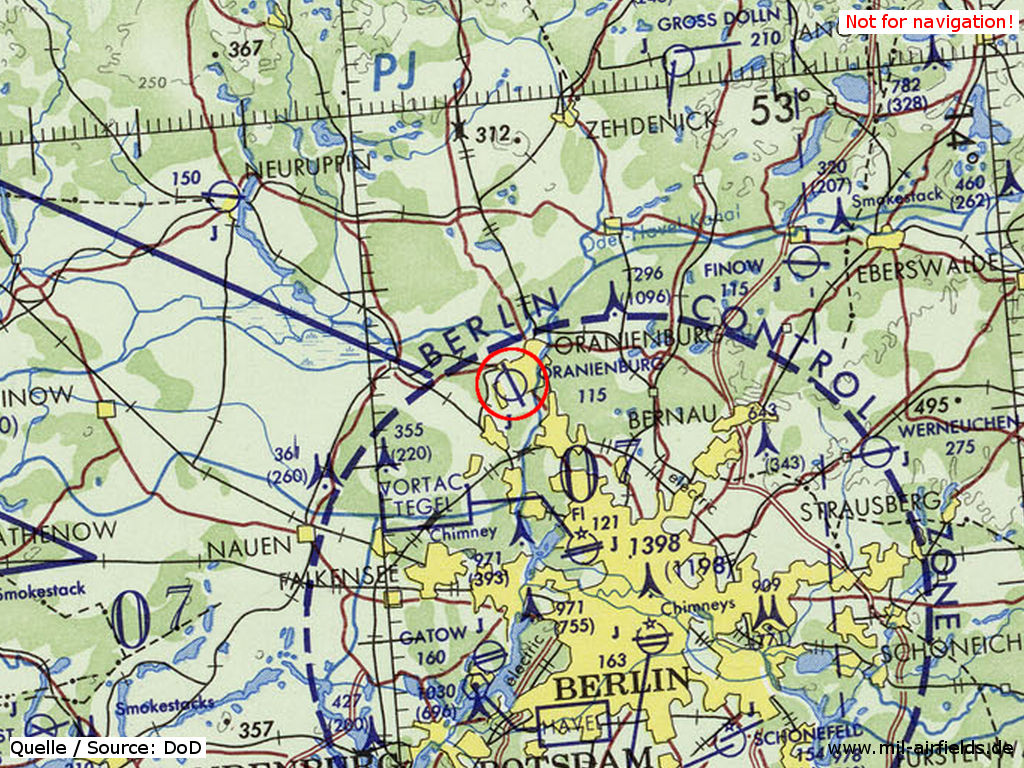
Oranienburg Air Base on a map of the US Department of Defense from 1972
Source: ONC E-2 (1972), Perry-Castañeda Library Map Collection, University of Texas at Austin /PCL MC/
Overview
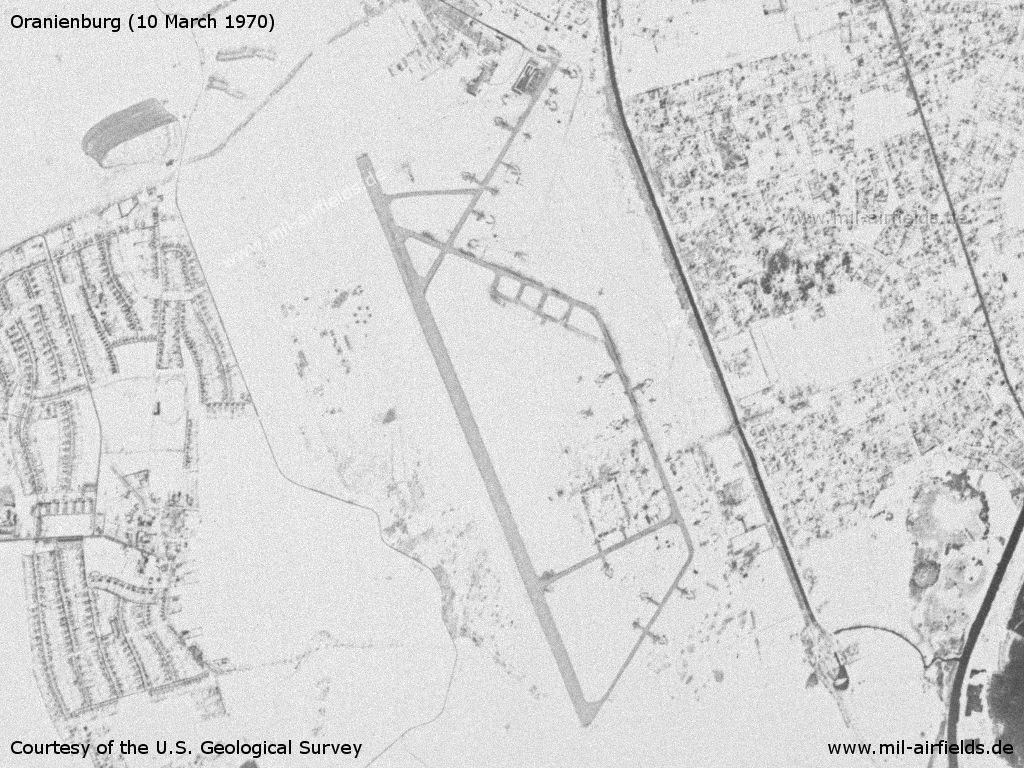
Oranienburg Air Base on a US satellite image from 10 March 1970 - The area is covered with snow
Source: U.S. Geological Survey
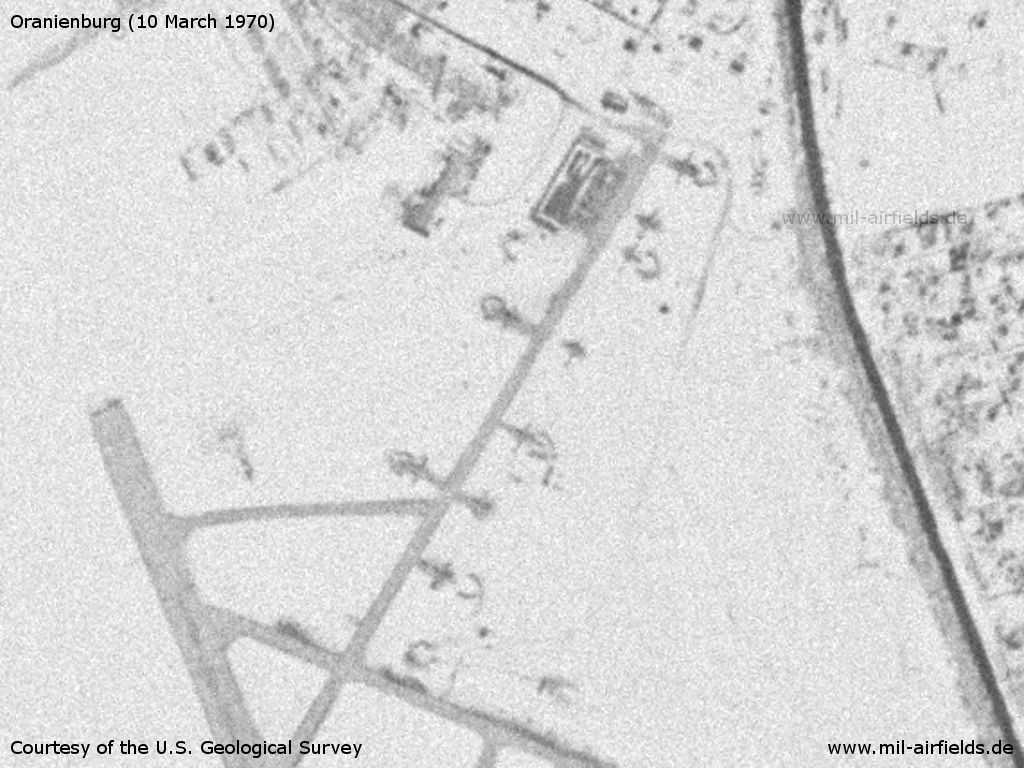
Parked aircraft in the northeastern part of the airfield
Source: U.S. Geological Survey
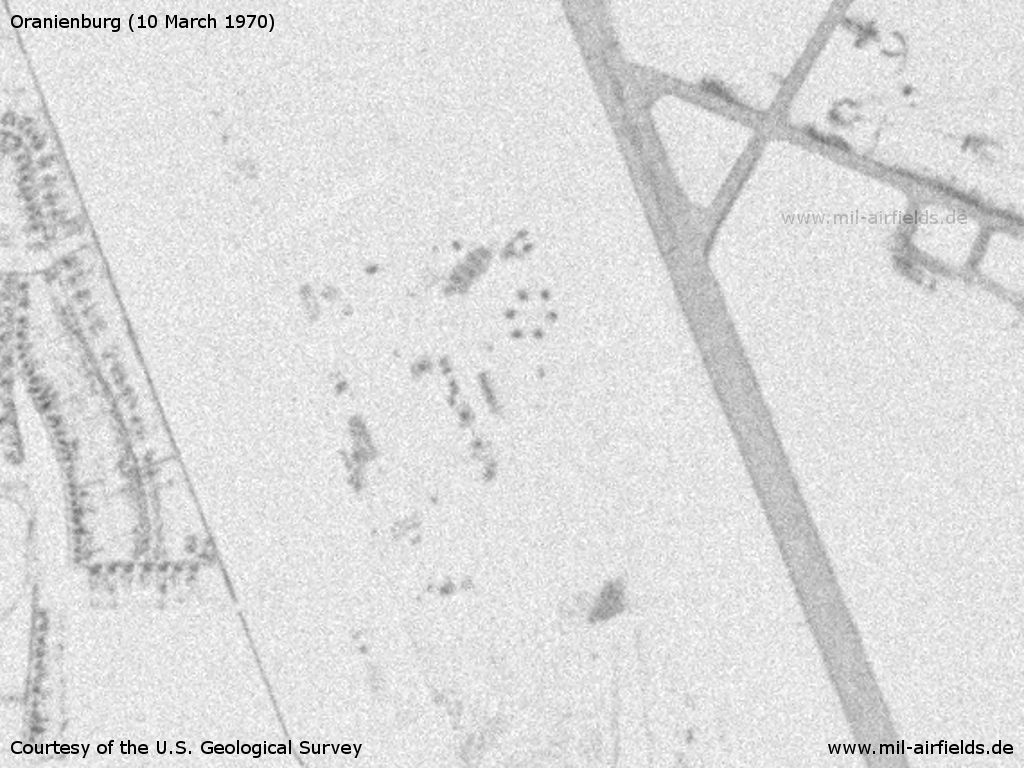
The six dots could be part of an anti-aircraft defense site
Source: U.S. Geological Survey
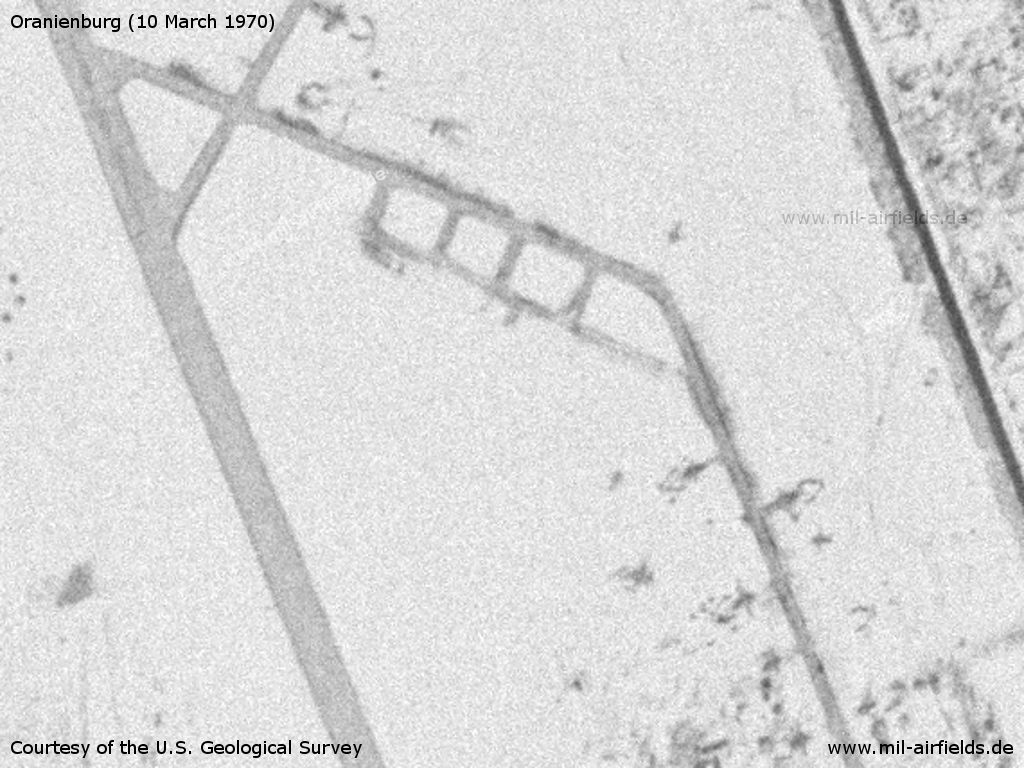
Transport aircraft are also visible in the central section
Source: U.S. Geological Survey
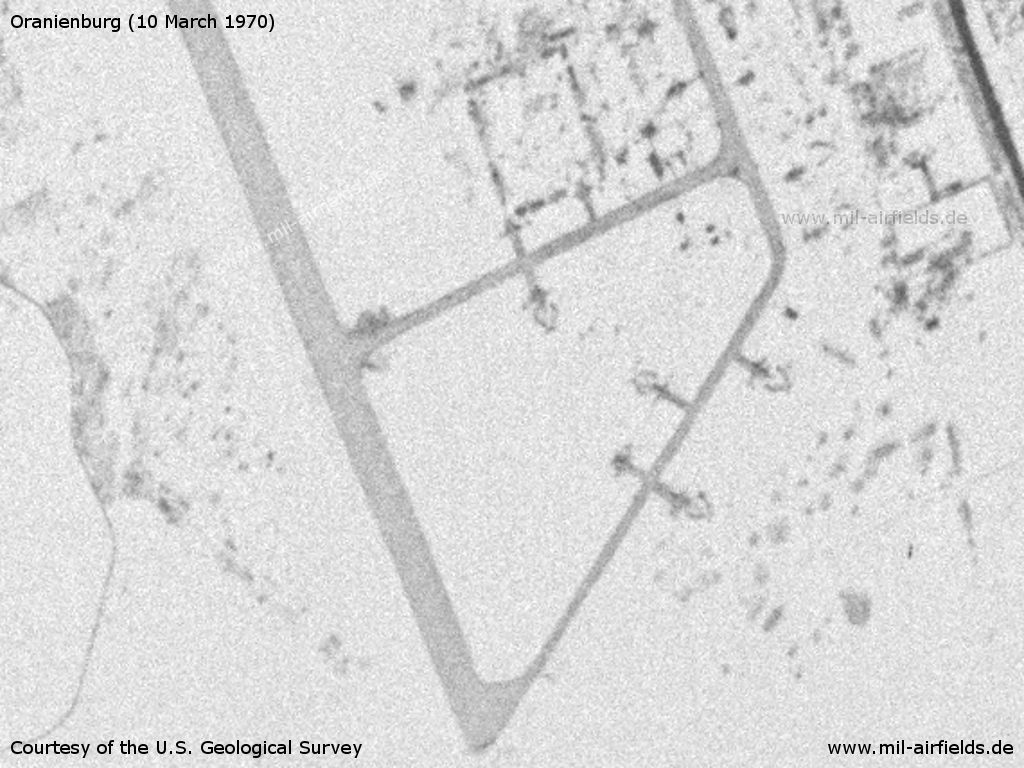
Southern part
Source: U.S. Geological Survey
In the 1980s and early 1990s
Runways
Data for the year 1990:
- 16/34: 2500 m Concrete
Radio beacons
Data for the year 1990:
- LOM 16: 589 "HL"
- LMM 16: 286 "H"
Radio communication
The radio call sign of the airfield was ZADAR (ЗАДАР).
Units
1990: 239 GwOVP (Mi-6, Mi-8, Mi-24)
Installations
The airfield was served by rail from the northwest.
Anti-aircraft missile site at Vehlefanz, about 6 kilometers to the west-southwest.
History
- 24 December 1984
Four Soviet Mi-8 helicopters try to force a US Army aircraft to land in Oranienburg. The aircraft of the type UV-20 was in the Berlin Control Zone, but continued its flight and landed again in Berlin-Tempelhof. (Source: CIA) - 1988
"Several sightings of HIP H at Parchim Soviet Airfield (2nd Guards Tank Army) and Stendal Soviet Airfield (3rd Shock Army) indicated these regiments were integrating this latest HIP-series assault variant into their inventories. Through bort number tracking we were able to discern that some of the HIP H had transferred from Oranienburg Soviet Airfield, previously the only base to have the Mi-17." Source: /USMLM 1988/ (Source: USMLM 1988)
Today
Use today
Closed. The former runway has been overbuilt with the federal road B96.The area is used as industrial zone and solar park.
Videos
- https://www.youtube.com/watch?v=yAfkbsf3niw - 1981 02 зима - Ораниенбург Parachute jumping in Oranienburg, in 1981?
- https://www.youtube.com/watch?v=545QFdeX0wQ - 1981 09 весна — Ораниенбург Soviet parade at the airfield
- https://www.youtube.com/watch?v=nhVP27DAFB8 - Ораниенбург. 239 Гвардейский отдельный вертолетный полк. Вывод Helicopter flight from Oranienburg to Templin / Groß Dölln in 1991.
- https://www.youtube.com/watch?v=8l2PdmSR1kY - Утро на аэродроме Ораниенбург (Morning at Oranienburg Airfield) Flight preparation, parachute jump.
- https://www.youtube.com/watch?v=3xjAiVMMSv0 - Вертолет Ми-6. Стрельба на полигоне Виттшток. Flight with a Mi-6 helicopter from Oranienburg to Wittstock firing range and back. At the beginning, the morse code of Oranienburg's outer beacon "HL" can be heard. Between 10:09 and 10:22, the Gadow Airfield Replica can be seen from above.
Sources
- /USMLM 1988/:
United States Military Liaison Mission: "Unit History 1988"
Links
- /CIA 1955/:
http://nsarchive.gwu.edu/nukevault/ebb538-Cold-War... - CIA-RDP80-00810A008200190011-2 - /Targets 1959/:
http://nsarchive.gwu.edu/nukevault/ebb538-Cold-War... - The National Security Archive: U.S. Cold War Nuclear Target Lists Declassified for First Time - National Security Archive Electronic Briefing Book No. 538, Edited by William Burr (2015-12-22) - /CIA Berlin 1961-06/:
http://www.foia.cia.gov/document/5166d4f999326091c... - CIA: Chronology of Events Concerning the Berlin Situation since 27 June 1961
Related topics
Airfields in the vicinity
Categories
Military Airfields GermanyMilitary Airfields in former East GermanyAirfields of the Soviet Forces in GermanyRecommended
Image credits are shown on the respective target page, click on the preview to open it.
Contents
